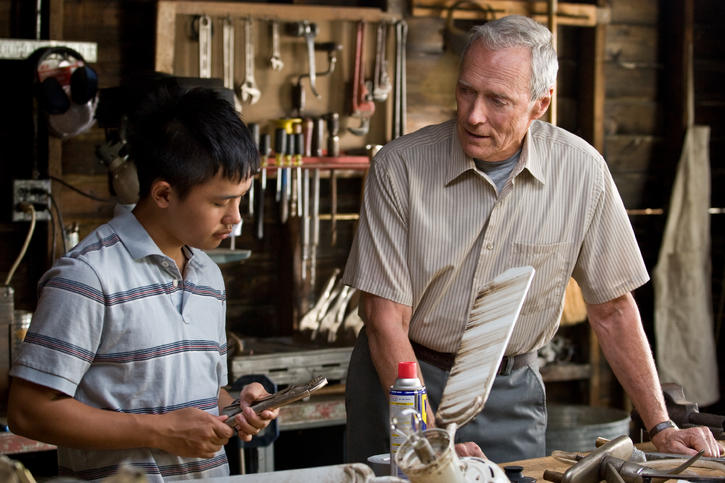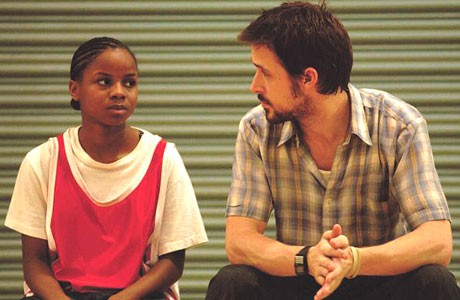main: June 2009 Archives
 What did the King of Pop bequeath to the world? Your answer will probably depend on your view of American pop music.
What did the King of Pop bequeath to the world? Your answer will probably depend on your view of American pop music.If you take the view that American pop music is nothing but a manufactured product designed to exploit human lust and desire, then you will focus on the seamy side of Jackson's career: the occasionally risque song lyrics and video images; the strangely whitened skin (caused by a disease called vitiligo, which destroys pigment); the bizarre cosmetic surgery that left him with an eerie mask-like appearance; and the tortured private life, tarnished by unproven but damning accusations of child molestation. Like Elvis Presley, Jackson became a superstar when he was too young to handle it, and by the time of his early death, he had become a freak.
But there is another side to Jackson. If you take the view that American pop music grows out of a rich tradition of song, dance, and showmanship created by African Americans but now practiced by performers of all backgrounds, then you will focus on the highlights of Jackson's career: the irresistible 10-year-old star of the Jackson 5; the gifted vocalist of Thriller (the 1982 album that has sold almost 65 million copies worldwide); the astonishing dancer whom critics compared with Fred Astaire and Rudolph Nureyev; the creator of artful music videos; and finally, the master of the extravagant live stage show.
What is the relationship between these two sides of Michael Jackson? The answer lies in the larger cultural context within which he lived. If Jackson had been born 50 years or even 25 years earlier, he would have joined a long list of extraordinary African-American musicians working in a succession of popular but also challenging styles: ragtime at the turn of the 20th century, jazz in the 1920s, swing in the 1930s, rhythm and blues in the 1940s, rock and roll in the 1950s. Or perhaps, coming as he did from a religious family (his mother is a devout Jehovah's Witness), Jackson would have been one of the century's great gospel singers.
Any of these styles would have kept Jackson close to what is best in American music. Indeed, he got his start within that tradition: the all-male singing group put together by his father has a long pedigree in both religious and secular realms. But Jackson was born in 1958 and began his career a decade later, during the tumultuous late 1960s, when pop music was changing very quickly - and not always for the better.
The greatest frustration of Jackson's life was that he never repeated his early success with Thriller. He tried, and several of his later albums sold millions of copies. But there was something magical about Thriller that seemed to elude him for years afterward. What was the source of that magic? I would say Quincy Jones, the older man who produced Jackson's first three solo albums.
Quincy Jones was born in 1933 and is still going strong, a trumpeter, arranger, producer, and all-around master who got his start playing and arranging for superb artists: Lionel Hampton, Sarah Vaughan, Count Basie, Duke Ellington, Gene Krupa, Ray Charles, Dizzy Gillespie. Not only that, but he studied composition with Nadia Boulanger and Olivier Messiaen in Paris. Few people on this earth know African-American music as well as Jones, and he wove that knowledge into every track of Thriller.
But nothing succeeds like success, and after his next album, Bad, Jackson decided that he did not need Jones any more, and the two parted company. The magic went out of Jackson's music at that point, and in my opinion, it stayed out. And Jackson let this happen because, after all, this was the 1980s, and there was more to being a superstar than just singing and dancing. There was MTV.
Amazing as it sounds, MTV in the early 1980s played mostly white acts, and for a while refused to air Jackson's videos. Finally his record company threatened MTV, and they yielded, only to discover that their largely white audience adored Michael Jackson. After this triumph, Jackson vowed to break every other barrier as well, and be accepted as a major artistic talent.
But unfortunately, Jackson's universe did not include the culturally sophisticated attitudes of the dominant musical style of the 1980s: the British New Wave. With its roots in punk, the visual arts, and trendy downtown fashion, the New Wave depended less on artistry than on attitude - a campy, ironic attitude that mocked commercial success while also pursuing it. This kind of thing was beyond Jackson's comprehension, and when the British press dubbed him "Wacko Jacko," he was deeply hurt.
Here we find the real explanation for Jackson's weird, sentimental notion of himself as a "spiritual" artist, a veritable angel of love. It was the only way he could fight back against the dark, cynical tone of the musical styles that surrounded him: punk, grunge, alternative, gangsta rap. It was a hit with people all around the world. (See comments from former Soviet bloc countries on the RFE-RL website.) But this was never enough. Jackson also longed to be taken as seriously at home, as seriously as the stars of these cynical styles. But he never was. The critics dismissed him as "pop," and the rest of the media focused on his eccentricities, not his genius.
Perhaps now that Michael Jackson has passed from the scene, it will be possible to reverse these priorities.
June 27, 2009 3:18 PM
| Permalink
 Don't be put off by Clint Eastwood's character at the beginning of Gran Torino (2008). It's a caricature of a cranky old widower, the only white resident left in a Highland Park, Michigan neighborhood, and it's so over the top you might feel tempted to bail out. Don't.
Don't be put off by Clint Eastwood's character at the beginning of Gran Torino (2008). It's a caricature of a cranky old widower, the only white resident left in a Highland Park, Michigan neighborhood, and it's so over the top you might feel tempted to bail out. Don't.According to the 2000 census, Highland Park is 93 percent African American, 4 percent white, and less than 1 percent Asian. But as it happens, Walt Kowalski (no relation to Stanley) is surrounded by Hmong immigrants, whom he dislikes quite intensely.
But eventually he befriends Thao and Sue Lor, the young son and daughter of the Hmong family next door. And true to Eastwood's persona, he also proves tougher than the local gang-bangers, who are out to enlist the timid, confused Thao. The bond between Walt and Thao is at the heart of the film, and it is wonderfully executed by Eastwood and a young Hmong actor named Bee Vang.
This is a classic American film in one key respect: it shows how learning to trust someone very different from you can be the cure for unhappiness and social isolation. But it takes some liberties that most such films do not.
For example, from beginning to end, Gran Torino shows Walt ladling out the racial and ethnic slurs. No one is spared, from his Italian barber, whom he calls a "guinea" just for starters, to his neighbors, who endure being called "gooks," slants," and "zipperheads" with stoic politeness (except the grandmother, who relishes insulting him back).
It's like listening to one of Don Rickles's outrageous comedy riffs, only most people would not see the humor. I do, because I come from Boston, one of the few cities left in America where ethnic insult, when delivered correctly, is still an accepted form of social lubrication. We see this in the wonderful scene where Walt helps Thao get a job on construction but must first "man him up" by teaching him how to insult without offending.
To judge by the commentary on the DVD, none of the young actors associated with this film understood that such talk is not "racism" or "bigotry." This is kind of amazing when you consider that they were the ones who made the film. But I won't criticize them, because to judge by the brilliant result, they got it in the end. All credit to Eastwood and the writer, Nick Schenk, for this slice of non-politically correct social trust in the making.
June 21, 2009 7:28 PM
| Permalink

It's an old American movie cliche: an affluent but mixed-up white character is helped and guided by a black character who, despite
being poor, is blessed with a head that is screwed on straight. In the old days the formula was a rich socialite and a salty, wise-cracking maid, or a great leader and a humble but wise valet. More recently we have seen a spoiled golfer and a clairvoyant caddy (The Legend of Bagger Vance) and a scruffy but honest cop and a smooth but honorable crook (American Gangster).
This hardly exhausts the list, but you get my drift. All the more credit, then, to the 2006 indie film Half Nelson, for making the old cliche new. Ryan Gosling is superb as a history teacher in a struggling Brooklyn middle school whose life is spiraling out of control, due to a cocaine habit rapidly turning into a crack addiction. His classes consist of pop Marxism laced with political ideas ca. 1968, but his mordant, self-effacing riffs capture the imagination of one student, a 13-year-old girl whose mother works long hours as a security guard and whose only other adult influence is the neighborhood drug dealer, who looks out for her because he feels responsible for having landed her older brother in prison.
When the student discovers the teacher's drug problem, the tables begin, ever so slowly and subtly, to turn -- until, without a single false note, the student emerges as the salvation (we hope) of the teacher.
Then best thing about Half Nelson is the performance of Shareeka Epps as a young girl who just happens to be the moral center of at least four other lives: her mother's, her brother's, (improbably) the drug dealer's -- and her teacher's. That's a lot to pull off, but Epps's performance looks effortless. She and Gosling are two of the most remarkable actors out there today (which is why they don't seem to be getting many parts).
I've already told you how the story comes out. But this is not a "feel-good" movie in the usual sense of the term. The ending is hardly uplifting, it just manages to lift us slightly higher than we were before -- and that feels not good, exactly, but somehow miraculous and believable.
This hardly exhausts the list, but you get my drift. All the more credit, then, to the 2006 indie film Half Nelson, for making the old cliche new. Ryan Gosling is superb as a history teacher in a struggling Brooklyn middle school whose life is spiraling out of control, due to a cocaine habit rapidly turning into a crack addiction. His classes consist of pop Marxism laced with political ideas ca. 1968, but his mordant, self-effacing riffs capture the imagination of one student, a 13-year-old girl whose mother works long hours as a security guard and whose only other adult influence is the neighborhood drug dealer, who looks out for her because he feels responsible for having landed her older brother in prison.
When the student discovers the teacher's drug problem, the tables begin, ever so slowly and subtly, to turn -- until, without a single false note, the student emerges as the salvation (we hope) of the teacher.
Then best thing about Half Nelson is the performance of Shareeka Epps as a young girl who just happens to be the moral center of at least four other lives: her mother's, her brother's, (improbably) the drug dealer's -- and her teacher's. That's a lot to pull off, but Epps's performance looks effortless. She and Gosling are two of the most remarkable actors out there today (which is why they don't seem to be getting many parts).
I've already told you how the story comes out. But this is not a "feel-good" movie in the usual sense of the term. The ending is hardly uplifting, it just manages to lift us slightly higher than we were before -- and that feels not good, exactly, but somehow miraculous and believable.
June 14, 2009 7:29 PM
| Permalink
